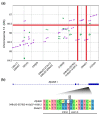Gv1, a Zinc Finger Gene Controlling Endogenous MLV Expression
- PMID: 33560369
- PMCID: PMC8136514
- DOI: 10.1093/molbev/msab039
Gv1, a Zinc Finger Gene Controlling Endogenous MLV Expression
Abstract
The genomes of inbred mice harbor around 50 endogenous murine leukemia virus (MLV) loci, although the specific complement varies greatly between strains. The Gv1 locus is known to control the transcription of endogenous MLVs and to be the dominant determinant of cell-surface presentation of MLV envelope, the GIX antigen. Here, we identify a single Krüppel-associated box zinc finger protein (ZFP) gene, Zfp998, as Gv1 and show it to be necessary and sufficient to determine the GIX+ phenotype. By long-read sequencing of bacterial artificial chromosome clones from 129 mice, the prototypic GIX+ strain, we reveal the source of sufficiency and deficiency as splice-acceptor variations and highlight the varying origins of the chromosomal region encompassing Gv1. Zfp998 becomes the second identified ZFP gene responsible for epigenetic suppression of endogenous MLVs in mice and further highlights the prominent role of this gene family in control of endogenous retroviruses.
Keywords: Gv1; Sgp3; KRAB ZFP; TRIM28; endogenous retrovirus; murine leukemia virus.
© The Author(s) 2021. Published by Oxford University Press on behalf of the Society for Molecular Biology and Evolution.
Figures



References
-
- Adams DJ, Quail MA, Cox T, Van Der Weyden L, Gorick BD, Su Q, Chan WI, Davies R, Bonfield JK, Law F, et al.2005. A genome-wide, end-sequenced 129Sv BAC library resource for targeting vector construction. Genomics 86(6):753–758. - PubMed
-
- Beck JA, Lloyd S, Hafezparast M, Lennon-Pierce M, Eppig JT, Festing MFW, Fisher EMC.. 2000. Genealogies of mouse inbred strains. Nat Genet 24(1):23–25. - PubMed
-
- Elder JH, Jensen FC, Bryant ML, Lerner RA.. 1977. Polymorphism of the major envelope glycoprotein (gp70) of murine C-type viruses: virion associated and differentiation antigens encoded by a multi-gene family. Nature 267(5606):23–28. - PubMed
Publication types
MeSH terms
Grants and funding
LinkOut - more resources
Full Text Sources
Other Literature Sources
Molecular Biology Databases
Miscellaneous

